Business Environment Report: National Grid Plc and Macro Factors
VerifiedAdded on 2020/11/12
|18
|5204
|230
Report
AI Summary
This report delves into the intricacies of the business environment, specifically within the energy sector, examining the interplay of demand and supply, and the application of price elasticity theory. It defines and explores the concept of fracking, analyzing its implications through the lens of stakeholder theory, and considers the perspectives of various stakeholders including internal (employees, managers) and external (consumers, regulators). The report further employs the PESTLE model to assess macro-environmental factors affecting the energy sector and includes an analysis of National Grid Plc. The report also discusses the challenges faced by businesses and their impact on the global environment. The report uses diagrams to illustrate the key concepts and findings.
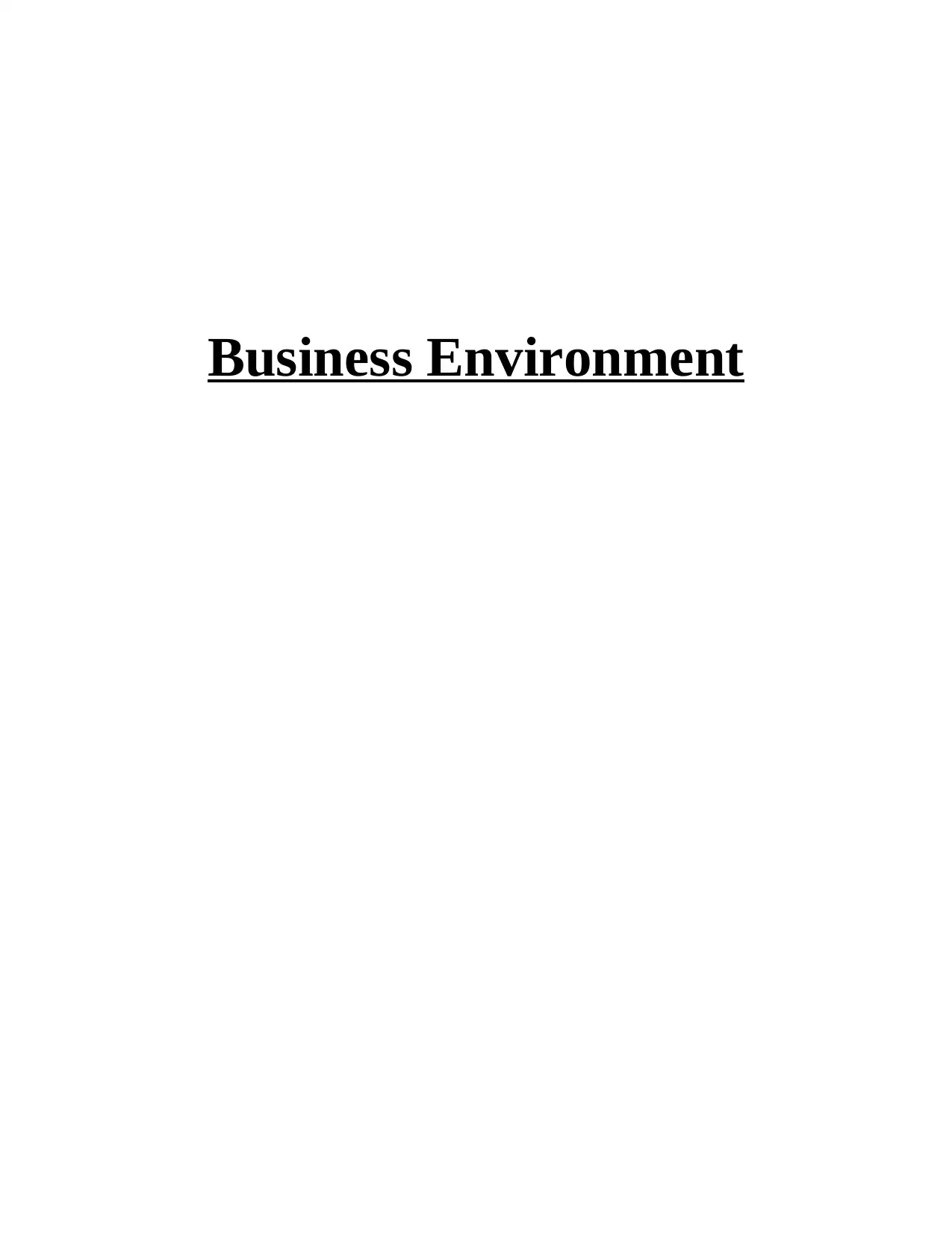
Business Environment
Paraphrase This Document
Need a fresh take? Get an instant paraphrase of this document with our AI Paraphraser
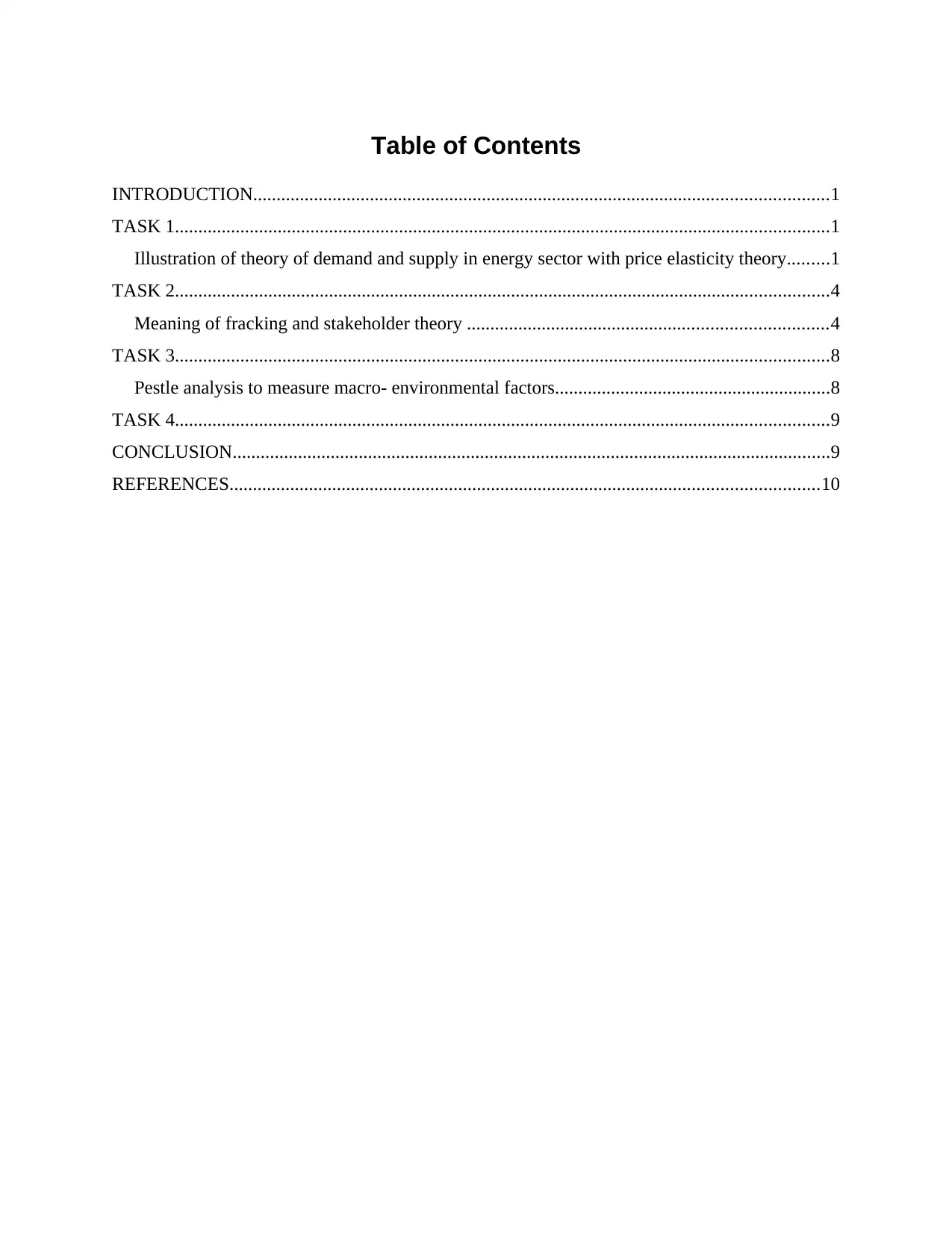
Table of Contents
INTRODUCTION...........................................................................................................................1
TASK 1............................................................................................................................................1
Illustration of theory of demand and supply in energy sector with price elasticity theory.........1
TASK 2............................................................................................................................................4
Meaning of fracking and stakeholder theory .............................................................................4
TASK 3............................................................................................................................................8
Pestle analysis to measure macro- environmental factors...........................................................8
TASK 4............................................................................................................................................9
CONCLUSION................................................................................................................................9
REFERENCES..............................................................................................................................10
INTRODUCTION...........................................................................................................................1
TASK 1............................................................................................................................................1
Illustration of theory of demand and supply in energy sector with price elasticity theory.........1
TASK 2............................................................................................................................................4
Meaning of fracking and stakeholder theory .............................................................................4
TASK 3............................................................................................................................................8
Pestle analysis to measure macro- environmental factors...........................................................8
TASK 4............................................................................................................................................9
CONCLUSION................................................................................................................................9
REFERENCES..............................................................................................................................10
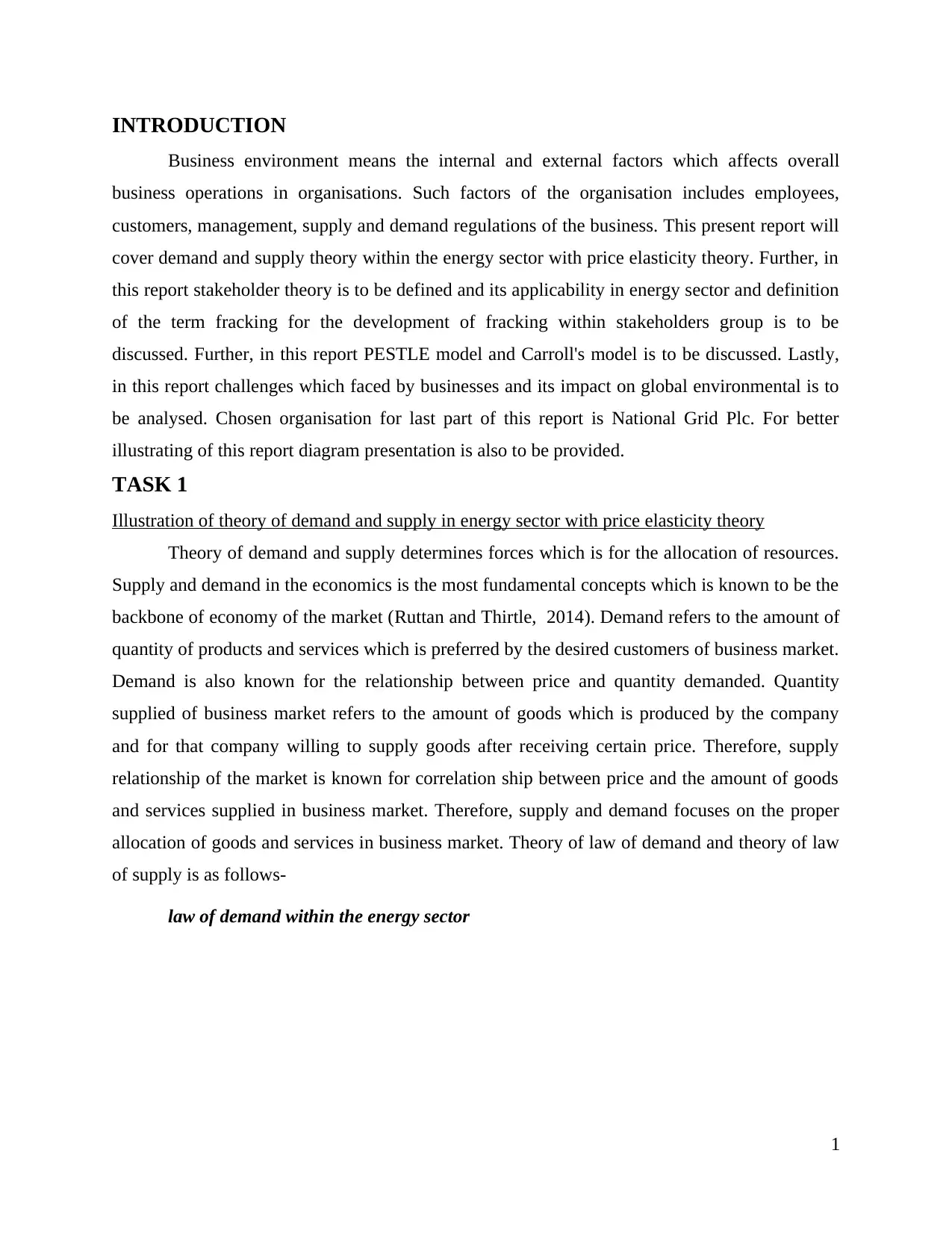
INTRODUCTION
Business environment means the internal and external factors which affects overall
business operations in organisations. Such factors of the organisation includes employees,
customers, management, supply and demand regulations of the business. This present report will
cover demand and supply theory within the energy sector with price elasticity theory. Further, in
this report stakeholder theory is to be defined and its applicability in energy sector and definition
of the term fracking for the development of fracking within stakeholders group is to be
discussed. Further, in this report PESTLE model and Carroll's model is to be discussed. Lastly,
in this report challenges which faced by businesses and its impact on global environmental is to
be analysed. Chosen organisation for last part of this report is National Grid Plc. For better
illustrating of this report diagram presentation is also to be provided.
TASK 1
Illustration of theory of demand and supply in energy sector with price elasticity theory
Theory of demand and supply determines forces which is for the allocation of resources.
Supply and demand in the economics is the most fundamental concepts which is known to be the
backbone of economy of the market (Ruttan and Thirtle, 2014). Demand refers to the amount of
quantity of products and services which is preferred by the desired customers of business market.
Demand is also known for the relationship between price and quantity demanded. Quantity
supplied of business market refers to the amount of goods which is produced by the company
and for that company willing to supply goods after receiving certain price. Therefore, supply
relationship of the market is known for correlation ship between price and the amount of goods
and services supplied in business market. Therefore, supply and demand focuses on the proper
allocation of goods and services in business market. Theory of law of demand and theory of law
of supply is as follows-
law of demand within the energy sector
1
Business environment means the internal and external factors which affects overall
business operations in organisations. Such factors of the organisation includes employees,
customers, management, supply and demand regulations of the business. This present report will
cover demand and supply theory within the energy sector with price elasticity theory. Further, in
this report stakeholder theory is to be defined and its applicability in energy sector and definition
of the term fracking for the development of fracking within stakeholders group is to be
discussed. Further, in this report PESTLE model and Carroll's model is to be discussed. Lastly,
in this report challenges which faced by businesses and its impact on global environmental is to
be analysed. Chosen organisation for last part of this report is National Grid Plc. For better
illustrating of this report diagram presentation is also to be provided.
TASK 1
Illustration of theory of demand and supply in energy sector with price elasticity theory
Theory of demand and supply determines forces which is for the allocation of resources.
Supply and demand in the economics is the most fundamental concepts which is known to be the
backbone of economy of the market (Ruttan and Thirtle, 2014). Demand refers to the amount of
quantity of products and services which is preferred by the desired customers of business market.
Demand is also known for the relationship between price and quantity demanded. Quantity
supplied of business market refers to the amount of goods which is produced by the company
and for that company willing to supply goods after receiving certain price. Therefore, supply
relationship of the market is known for correlation ship between price and the amount of goods
and services supplied in business market. Therefore, supply and demand focuses on the proper
allocation of goods and services in business market. Theory of law of demand and theory of law
of supply is as follows-
law of demand within the energy sector
1
⊘ This is a preview!⊘
Do you want full access?
Subscribe today to unlock all pages.

Trusted by 1+ million students worldwide
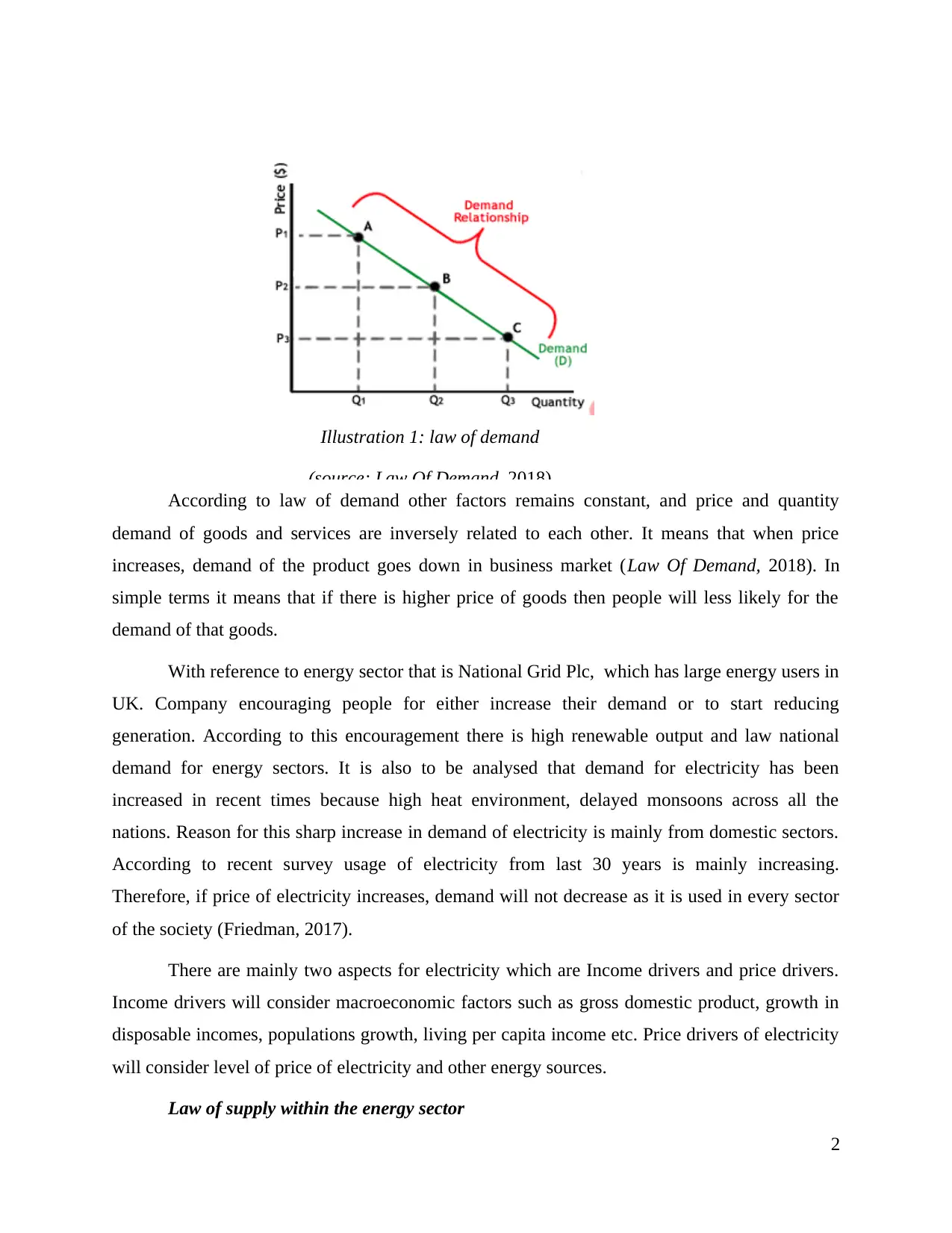
According to law of demand other factors remains constant, and price and quantity
demand of goods and services are inversely related to each other. It means that when price
increases, demand of the product goes down in business market (Law Of Demand, 2018). In
simple terms it means that if there is higher price of goods then people will less likely for the
demand of that goods.
With reference to energy sector that is National Grid Plc, which has large energy users in
UK. Company encouraging people for either increase their demand or to start reducing
generation. According to this encouragement there is high renewable output and law national
demand for energy sectors. It is also to be analysed that demand for electricity has been
increased in recent times because high heat environment, delayed monsoons across all the
nations. Reason for this sharp increase in demand of electricity is mainly from domestic sectors.
According to recent survey usage of electricity from last 30 years is mainly increasing.
Therefore, if price of electricity increases, demand will not decrease as it is used in every sector
of the society (Friedman, 2017).
There are mainly two aspects for electricity which are Income drivers and price drivers.
Income drivers will consider macroeconomic factors such as gross domestic product, growth in
disposable incomes, populations growth, living per capita income etc. Price drivers of electricity
will consider level of price of electricity and other energy sources.
Law of supply within the energy sector
2
Illustration 1: law of demand
(source: Law Of Demand, 2018)
demand of goods and services are inversely related to each other. It means that when price
increases, demand of the product goes down in business market (Law Of Demand, 2018). In
simple terms it means that if there is higher price of goods then people will less likely for the
demand of that goods.
With reference to energy sector that is National Grid Plc, which has large energy users in
UK. Company encouraging people for either increase their demand or to start reducing
generation. According to this encouragement there is high renewable output and law national
demand for energy sectors. It is also to be analysed that demand for electricity has been
increased in recent times because high heat environment, delayed monsoons across all the
nations. Reason for this sharp increase in demand of electricity is mainly from domestic sectors.
According to recent survey usage of electricity from last 30 years is mainly increasing.
Therefore, if price of electricity increases, demand will not decrease as it is used in every sector
of the society (Friedman, 2017).
There are mainly two aspects for electricity which are Income drivers and price drivers.
Income drivers will consider macroeconomic factors such as gross domestic product, growth in
disposable incomes, populations growth, living per capita income etc. Price drivers of electricity
will consider level of price of electricity and other energy sources.
Law of supply within the energy sector
2
Illustration 1: law of demand
(source: Law Of Demand, 2018)
Paraphrase This Document
Need a fresh take? Get an instant paraphrase of this document with our AI Paraphraser
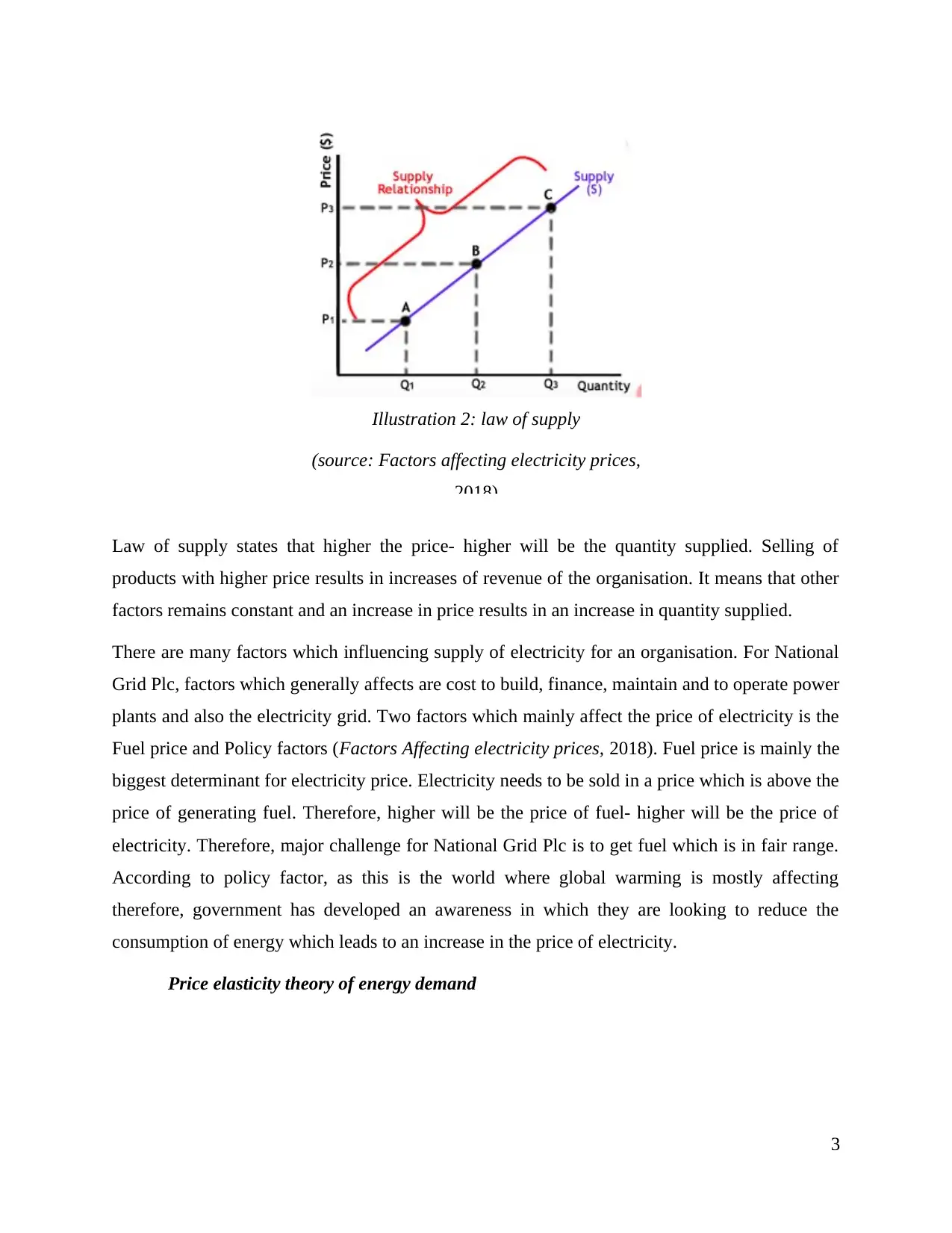
Law of supply states that higher the price- higher will be the quantity supplied. Selling of
products with higher price results in increases of revenue of the organisation. It means that other
factors remains constant and an increase in price results in an increase in quantity supplied.
There are many factors which influencing supply of electricity for an organisation. For National
Grid Plc, factors which generally affects are cost to build, finance, maintain and to operate power
plants and also the electricity grid. Two factors which mainly affect the price of electricity is the
Fuel price and Policy factors (Factors Affecting electricity prices, 2018). Fuel price is mainly the
biggest determinant for electricity price. Electricity needs to be sold in a price which is above the
price of generating fuel. Therefore, higher will be the price of fuel- higher will be the price of
electricity. Therefore, major challenge for National Grid Plc is to get fuel which is in fair range.
According to policy factor, as this is the world where global warming is mostly affecting
therefore, government has developed an awareness in which they are looking to reduce the
consumption of energy which leads to an increase in the price of electricity.
Price elasticity theory of energy demand
3
Illustration 2: law of supply
(source: Factors affecting electricity prices,
2018)
products with higher price results in increases of revenue of the organisation. It means that other
factors remains constant and an increase in price results in an increase in quantity supplied.
There are many factors which influencing supply of electricity for an organisation. For National
Grid Plc, factors which generally affects are cost to build, finance, maintain and to operate power
plants and also the electricity grid. Two factors which mainly affect the price of electricity is the
Fuel price and Policy factors (Factors Affecting electricity prices, 2018). Fuel price is mainly the
biggest determinant for electricity price. Electricity needs to be sold in a price which is above the
price of generating fuel. Therefore, higher will be the price of fuel- higher will be the price of
electricity. Therefore, major challenge for National Grid Plc is to get fuel which is in fair range.
According to policy factor, as this is the world where global warming is mostly affecting
therefore, government has developed an awareness in which they are looking to reduce the
consumption of energy which leads to an increase in the price of electricity.
Price elasticity theory of energy demand
3
Illustration 2: law of supply
(source: Factors affecting electricity prices,
2018)
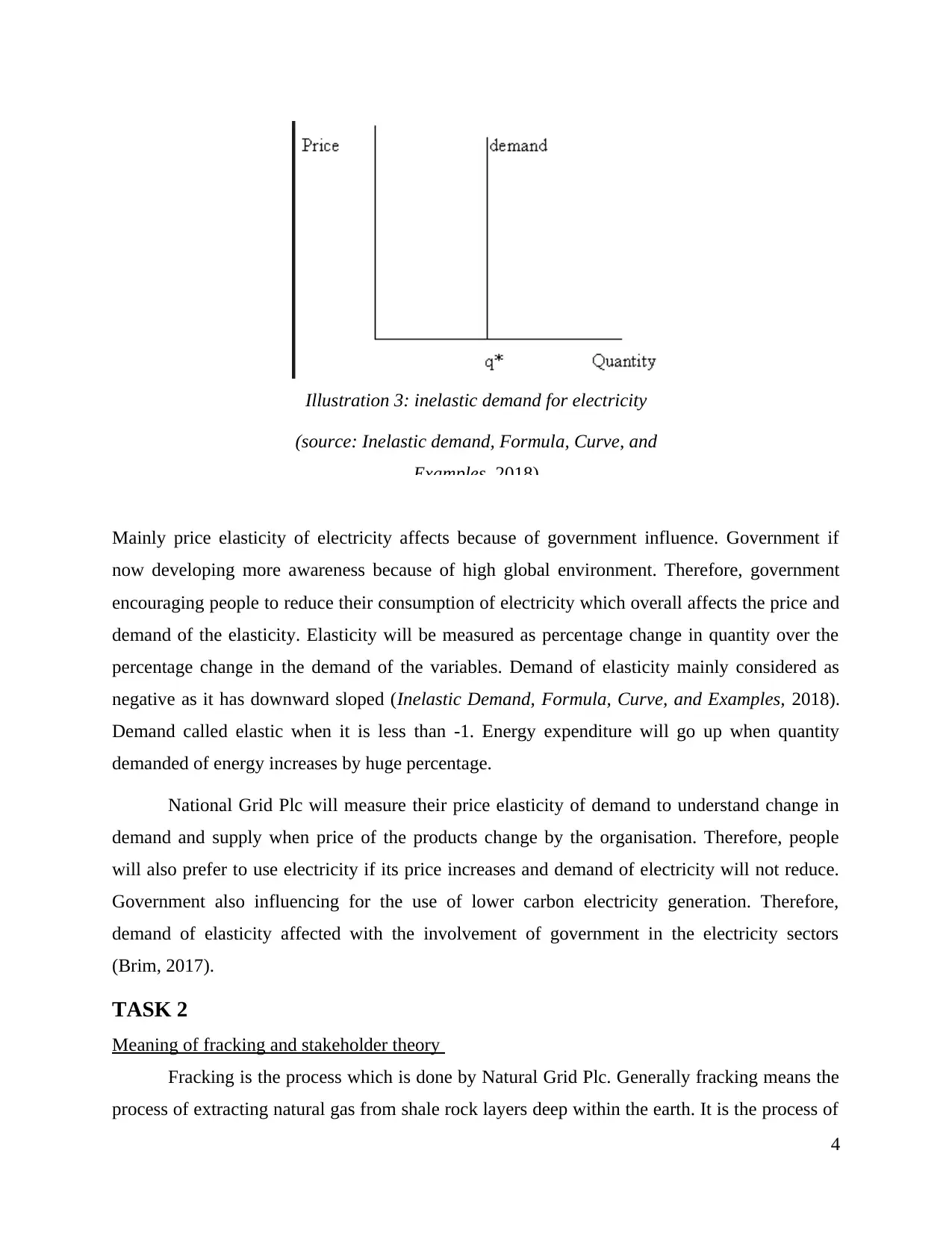
Mainly price elasticity of electricity affects because of government influence. Government if
now developing more awareness because of high global environment. Therefore, government
encouraging people to reduce their consumption of electricity which overall affects the price and
demand of the elasticity. Elasticity will be measured as percentage change in quantity over the
percentage change in the demand of the variables. Demand of elasticity mainly considered as
negative as it has downward sloped (Inelastic Demand, Formula, Curve, and Examples, 2018).
Demand called elastic when it is less than -1. Energy expenditure will go up when quantity
demanded of energy increases by huge percentage.
National Grid Plc will measure their price elasticity of demand to understand change in
demand and supply when price of the products change by the organisation. Therefore, people
will also prefer to use electricity if its price increases and demand of electricity will not reduce.
Government also influencing for the use of lower carbon electricity generation. Therefore,
demand of elasticity affected with the involvement of government in the electricity sectors
(Brim, 2017).
TASK 2
Meaning of fracking and stakeholder theory
Fracking is the process which is done by Natural Grid Plc. Generally fracking means the
process of extracting natural gas from shale rock layers deep within the earth. It is the process of
4
Illustration 3: inelastic demand for electricity
(source: Inelastic demand, Formula, Curve, and
Examples, 2018)
now developing more awareness because of high global environment. Therefore, government
encouraging people to reduce their consumption of electricity which overall affects the price and
demand of the elasticity. Elasticity will be measured as percentage change in quantity over the
percentage change in the demand of the variables. Demand of elasticity mainly considered as
negative as it has downward sloped (Inelastic Demand, Formula, Curve, and Examples, 2018).
Demand called elastic when it is less than -1. Energy expenditure will go up when quantity
demanded of energy increases by huge percentage.
National Grid Plc will measure their price elasticity of demand to understand change in
demand and supply when price of the products change by the organisation. Therefore, people
will also prefer to use electricity if its price increases and demand of electricity will not reduce.
Government also influencing for the use of lower carbon electricity generation. Therefore,
demand of elasticity affected with the involvement of government in the electricity sectors
(Brim, 2017).
TASK 2
Meaning of fracking and stakeholder theory
Fracking is the process which is done by Natural Grid Plc. Generally fracking means the
process of extracting natural gas from shale rock layers deep within the earth. It is the process of
4
Illustration 3: inelastic demand for electricity
(source: Inelastic demand, Formula, Curve, and
Examples, 2018)
⊘ This is a preview!⊘
Do you want full access?
Subscribe today to unlock all pages.

Trusted by 1+ million students worldwide
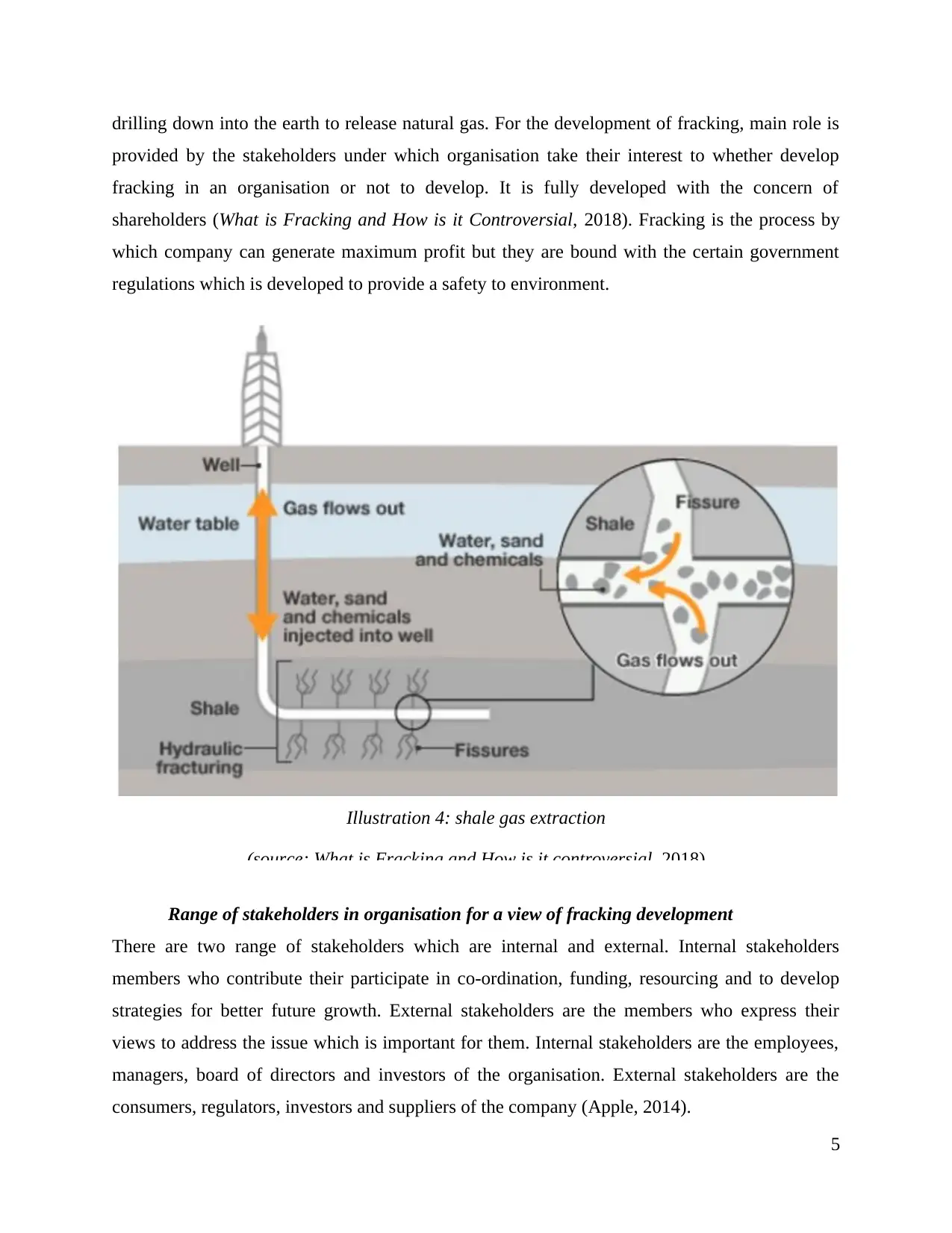
drilling down into the earth to release natural gas. For the development of fracking, main role is
provided by the stakeholders under which organisation take their interest to whether develop
fracking in an organisation or not to develop. It is fully developed with the concern of
shareholders (What is Fracking and How is it Controversial, 2018). Fracking is the process by
which company can generate maximum profit but they are bound with the certain government
regulations which is developed to provide a safety to environment.
Range of stakeholders in organisation for a view of fracking development
There are two range of stakeholders which are internal and external. Internal stakeholders
members who contribute their participate in co-ordination, funding, resourcing and to develop
strategies for better future growth. External stakeholders are the members who express their
views to address the issue which is important for them. Internal stakeholders are the employees,
managers, board of directors and investors of the organisation. External stakeholders are the
consumers, regulators, investors and suppliers of the company (Apple, 2014).
5
Illustration 4: shale gas extraction
(source: What is Fracking and How is it controversial, 2018)
provided by the stakeholders under which organisation take their interest to whether develop
fracking in an organisation or not to develop. It is fully developed with the concern of
shareholders (What is Fracking and How is it Controversial, 2018). Fracking is the process by
which company can generate maximum profit but they are bound with the certain government
regulations which is developed to provide a safety to environment.
Range of stakeholders in organisation for a view of fracking development
There are two range of stakeholders which are internal and external. Internal stakeholders
members who contribute their participate in co-ordination, funding, resourcing and to develop
strategies for better future growth. External stakeholders are the members who express their
views to address the issue which is important for them. Internal stakeholders are the employees,
managers, board of directors and investors of the organisation. External stakeholders are the
consumers, regulators, investors and suppliers of the company (Apple, 2014).
5
Illustration 4: shale gas extraction
(source: What is Fracking and How is it controversial, 2018)
Paraphrase This Document
Need a fresh take? Get an instant paraphrase of this document with our AI Paraphraser
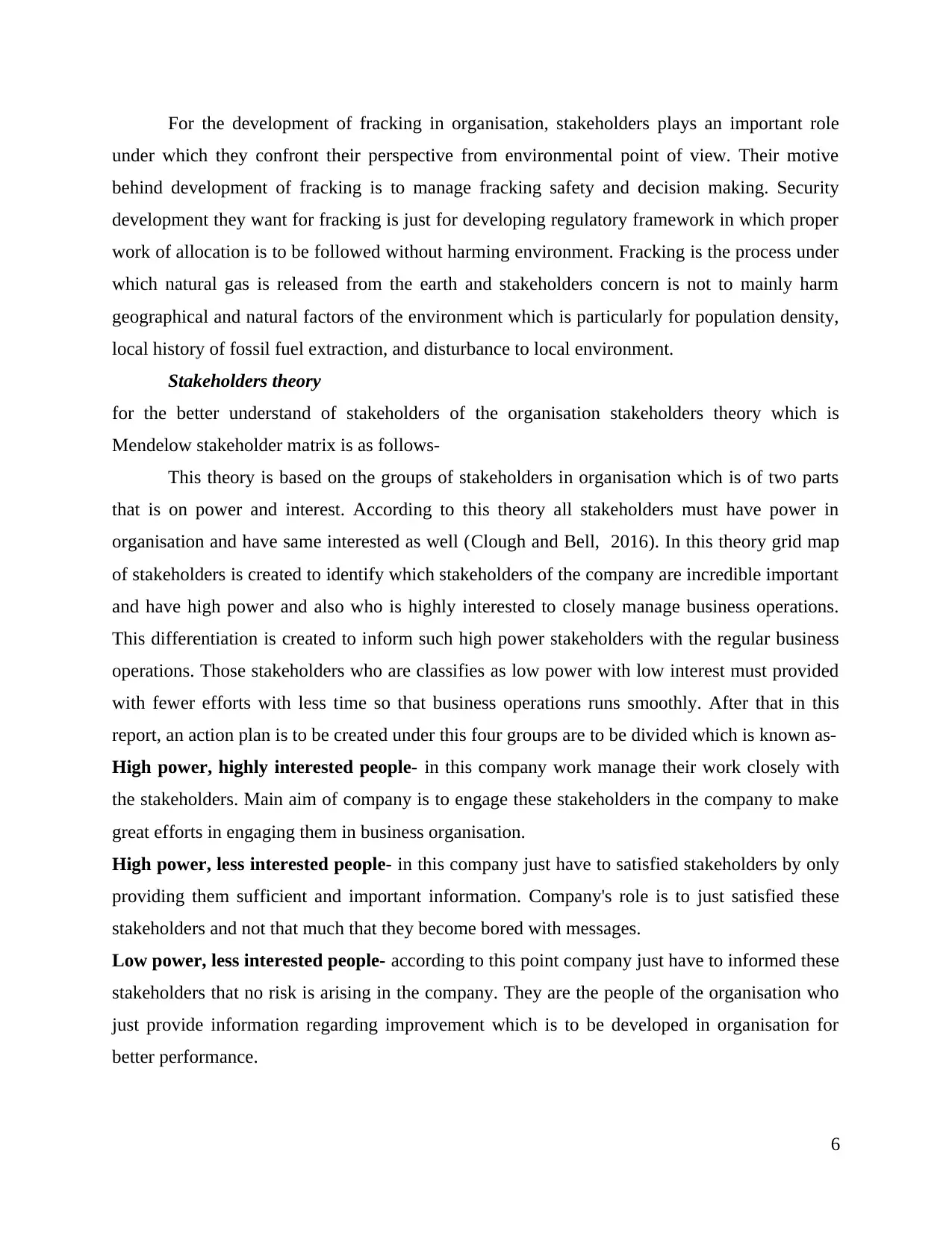
For the development of fracking in organisation, stakeholders plays an important role
under which they confront their perspective from environmental point of view. Their motive
behind development of fracking is to manage fracking safety and decision making. Security
development they want for fracking is just for developing regulatory framework in which proper
work of allocation is to be followed without harming environment. Fracking is the process under
which natural gas is released from the earth and stakeholders concern is not to mainly harm
geographical and natural factors of the environment which is particularly for population density,
local history of fossil fuel extraction, and disturbance to local environment.
Stakeholders theory
for the better understand of stakeholders of the organisation stakeholders theory which is
Mendelow stakeholder matrix is as follows-
This theory is based on the groups of stakeholders in organisation which is of two parts
that is on power and interest. According to this theory all stakeholders must have power in
organisation and have same interested as well (Clough and Bell, 2016). In this theory grid map
of stakeholders is created to identify which stakeholders of the company are incredible important
and have high power and also who is highly interested to closely manage business operations.
This differentiation is created to inform such high power stakeholders with the regular business
operations. Those stakeholders who are classifies as low power with low interest must provided
with fewer efforts with less time so that business operations runs smoothly. After that in this
report, an action plan is to be created under this four groups are to be divided which is known as-
High power, highly interested people- in this company work manage their work closely with
the stakeholders. Main aim of company is to engage these stakeholders in the company to make
great efforts in engaging them in business organisation.
High power, less interested people- in this company just have to satisfied stakeholders by only
providing them sufficient and important information. Company's role is to just satisfied these
stakeholders and not that much that they become bored with messages.
Low power, less interested people- according to this point company just have to informed these
stakeholders that no risk is arising in the company. They are the people of the organisation who
just provide information regarding improvement which is to be developed in organisation for
better performance.
6
under which they confront their perspective from environmental point of view. Their motive
behind development of fracking is to manage fracking safety and decision making. Security
development they want for fracking is just for developing regulatory framework in which proper
work of allocation is to be followed without harming environment. Fracking is the process under
which natural gas is released from the earth and stakeholders concern is not to mainly harm
geographical and natural factors of the environment which is particularly for population density,
local history of fossil fuel extraction, and disturbance to local environment.
Stakeholders theory
for the better understand of stakeholders of the organisation stakeholders theory which is
Mendelow stakeholder matrix is as follows-
This theory is based on the groups of stakeholders in organisation which is of two parts
that is on power and interest. According to this theory all stakeholders must have power in
organisation and have same interested as well (Clough and Bell, 2016). In this theory grid map
of stakeholders is created to identify which stakeholders of the company are incredible important
and have high power and also who is highly interested to closely manage business operations.
This differentiation is created to inform such high power stakeholders with the regular business
operations. Those stakeholders who are classifies as low power with low interest must provided
with fewer efforts with less time so that business operations runs smoothly. After that in this
report, an action plan is to be created under this four groups are to be divided which is known as-
High power, highly interested people- in this company work manage their work closely with
the stakeholders. Main aim of company is to engage these stakeholders in the company to make
great efforts in engaging them in business organisation.
High power, less interested people- in this company just have to satisfied stakeholders by only
providing them sufficient and important information. Company's role is to just satisfied these
stakeholders and not that much that they become bored with messages.
Low power, less interested people- according to this point company just have to informed these
stakeholders that no risk is arising in the company. They are the people of the organisation who
just provide information regarding improvement which is to be developed in organisation for
better performance.
6
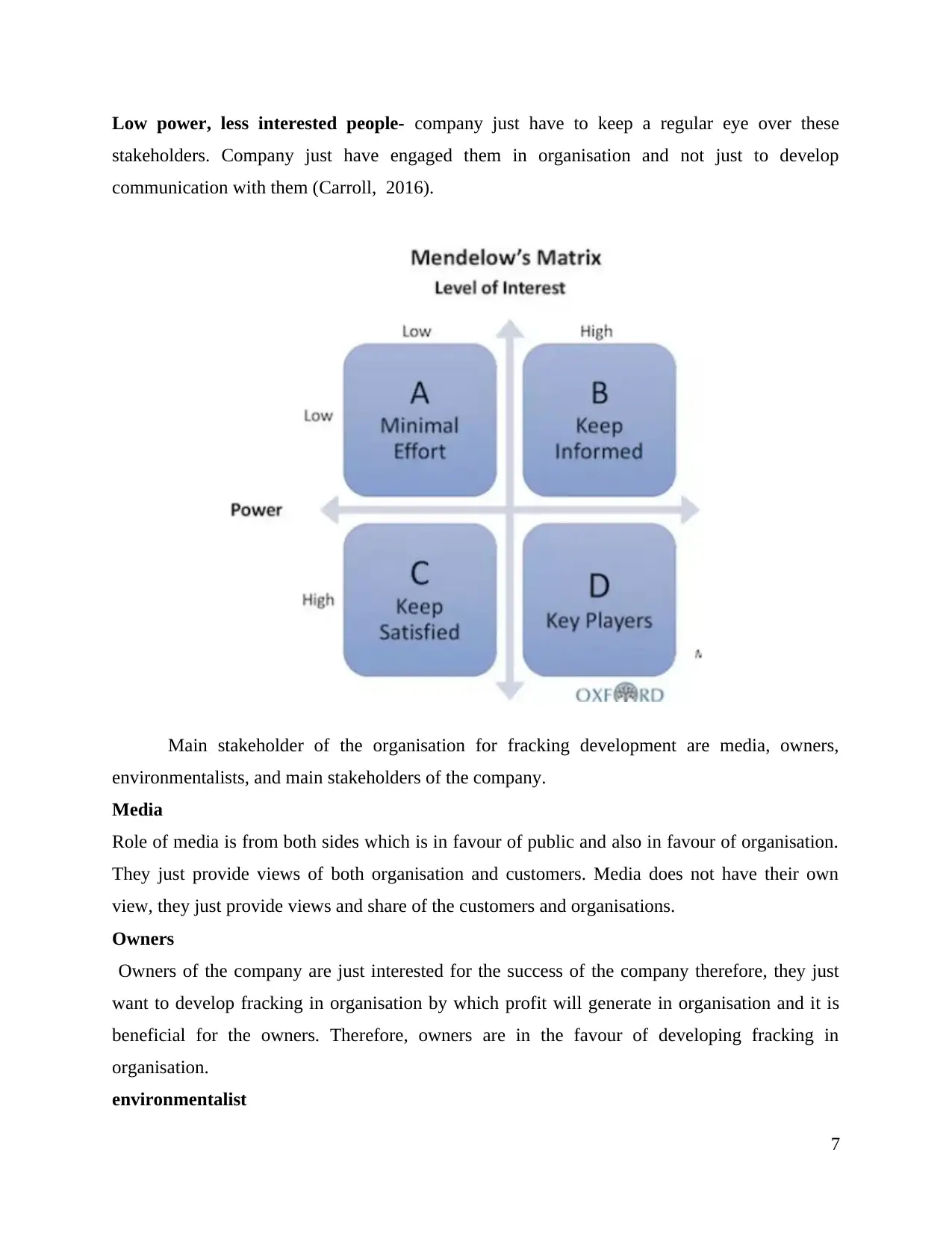
Low power, less interested people- company just have to keep a regular eye over these
stakeholders. Company just have engaged them in organisation and not just to develop
communication with them (Carroll, 2016).
Main stakeholder of the organisation for fracking development are media, owners,
environmentalists, and main stakeholders of the company.
Media
Role of media is from both sides which is in favour of public and also in favour of organisation.
They just provide views of both organisation and customers. Media does not have their own
view, they just provide views and share of the customers and organisations.
Owners
Owners of the company are just interested for the success of the company therefore, they just
want to develop fracking in organisation by which profit will generate in organisation and it is
beneficial for the owners. Therefore, owners are in the favour of developing fracking in
organisation.
environmentalist
7
stakeholders. Company just have engaged them in organisation and not just to develop
communication with them (Carroll, 2016).
Main stakeholder of the organisation for fracking development are media, owners,
environmentalists, and main stakeholders of the company.
Media
Role of media is from both sides which is in favour of public and also in favour of organisation.
They just provide views of both organisation and customers. Media does not have their own
view, they just provide views and share of the customers and organisations.
Owners
Owners of the company are just interested for the success of the company therefore, they just
want to develop fracking in organisation by which profit will generate in organisation and it is
beneficial for the owners. Therefore, owners are in the favour of developing fracking in
organisation.
environmentalist
7
⊘ This is a preview!⊘
Do you want full access?
Subscribe today to unlock all pages.

Trusted by 1+ million students worldwide
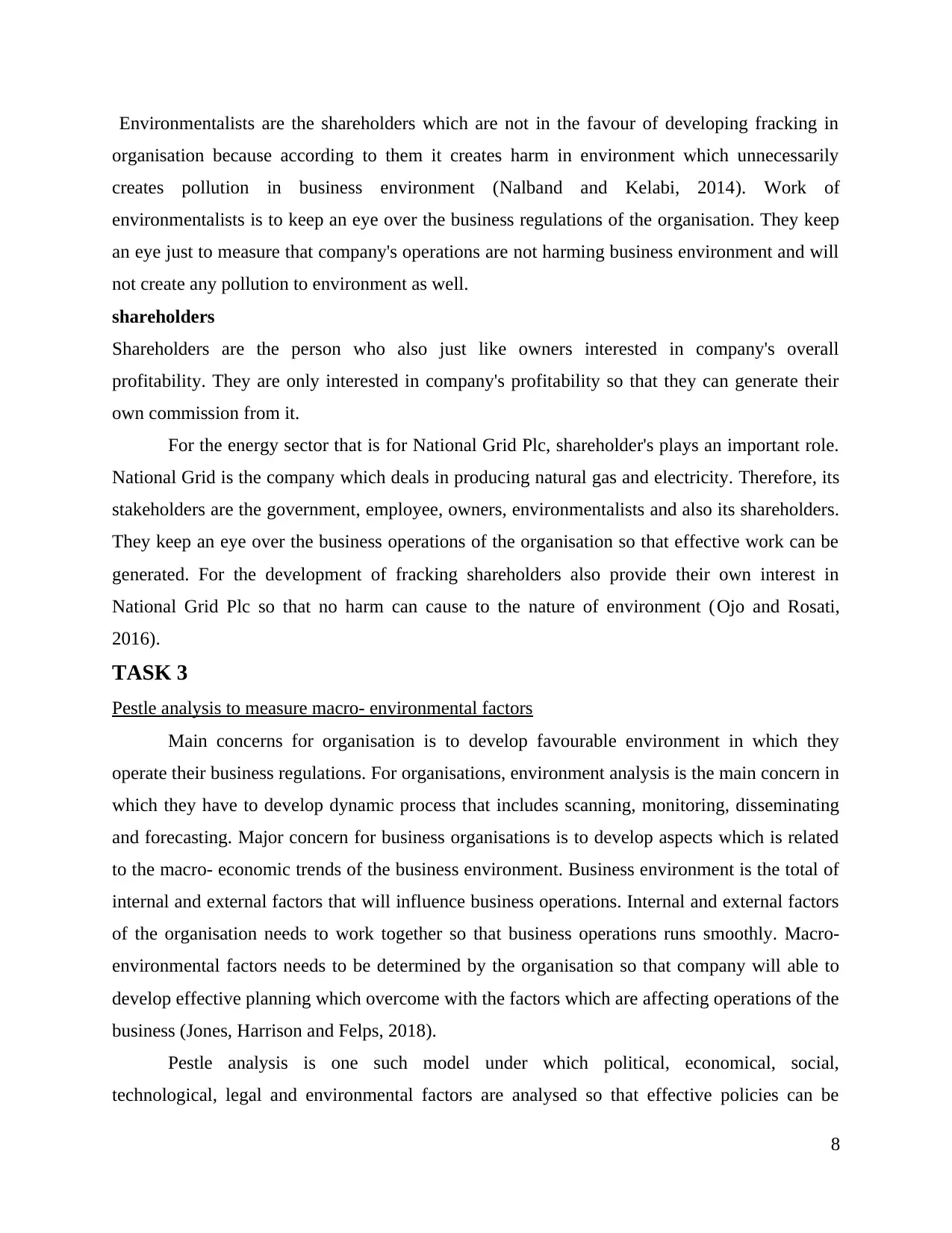
Environmentalists are the shareholders which are not in the favour of developing fracking in
organisation because according to them it creates harm in environment which unnecessarily
creates pollution in business environment (Nalband and Kelabi, 2014). Work of
environmentalists is to keep an eye over the business regulations of the organisation. They keep
an eye just to measure that company's operations are not harming business environment and will
not create any pollution to environment as well.
shareholders
Shareholders are the person who also just like owners interested in company's overall
profitability. They are only interested in company's profitability so that they can generate their
own commission from it.
For the energy sector that is for National Grid Plc, shareholder's plays an important role.
National Grid is the company which deals in producing natural gas and electricity. Therefore, its
stakeholders are the government, employee, owners, environmentalists and also its shareholders.
They keep an eye over the business operations of the organisation so that effective work can be
generated. For the development of fracking shareholders also provide their own interest in
National Grid Plc so that no harm can cause to the nature of environment (Ojo and Rosati,
2016).
TASK 3
Pestle analysis to measure macro- environmental factors
Main concerns for organisation is to develop favourable environment in which they
operate their business regulations. For organisations, environment analysis is the main concern in
which they have to develop dynamic process that includes scanning, monitoring, disseminating
and forecasting. Major concern for business organisations is to develop aspects which is related
to the macro- economic trends of the business environment. Business environment is the total of
internal and external factors that will influence business operations. Internal and external factors
of the organisation needs to work together so that business operations runs smoothly. Macro-
environmental factors needs to be determined by the organisation so that company will able to
develop effective planning which overcome with the factors which are affecting operations of the
business (Jones, Harrison and Felps, 2018).
Pestle analysis is one such model under which political, economical, social,
technological, legal and environmental factors are analysed so that effective policies can be
8
organisation because according to them it creates harm in environment which unnecessarily
creates pollution in business environment (Nalband and Kelabi, 2014). Work of
environmentalists is to keep an eye over the business regulations of the organisation. They keep
an eye just to measure that company's operations are not harming business environment and will
not create any pollution to environment as well.
shareholders
Shareholders are the person who also just like owners interested in company's overall
profitability. They are only interested in company's profitability so that they can generate their
own commission from it.
For the energy sector that is for National Grid Plc, shareholder's plays an important role.
National Grid is the company which deals in producing natural gas and electricity. Therefore, its
stakeholders are the government, employee, owners, environmentalists and also its shareholders.
They keep an eye over the business operations of the organisation so that effective work can be
generated. For the development of fracking shareholders also provide their own interest in
National Grid Plc so that no harm can cause to the nature of environment (Ojo and Rosati,
2016).
TASK 3
Pestle analysis to measure macro- environmental factors
Main concerns for organisation is to develop favourable environment in which they
operate their business regulations. For organisations, environment analysis is the main concern in
which they have to develop dynamic process that includes scanning, monitoring, disseminating
and forecasting. Major concern for business organisations is to develop aspects which is related
to the macro- economic trends of the business environment. Business environment is the total of
internal and external factors that will influence business operations. Internal and external factors
of the organisation needs to work together so that business operations runs smoothly. Macro-
environmental factors needs to be determined by the organisation so that company will able to
develop effective planning which overcome with the factors which are affecting operations of the
business (Jones, Harrison and Felps, 2018).
Pestle analysis is one such model under which political, economical, social,
technological, legal and environmental factors are analysed so that effective policies can be
8
Paraphrase This Document
Need a fresh take? Get an instant paraphrase of this document with our AI Paraphraser
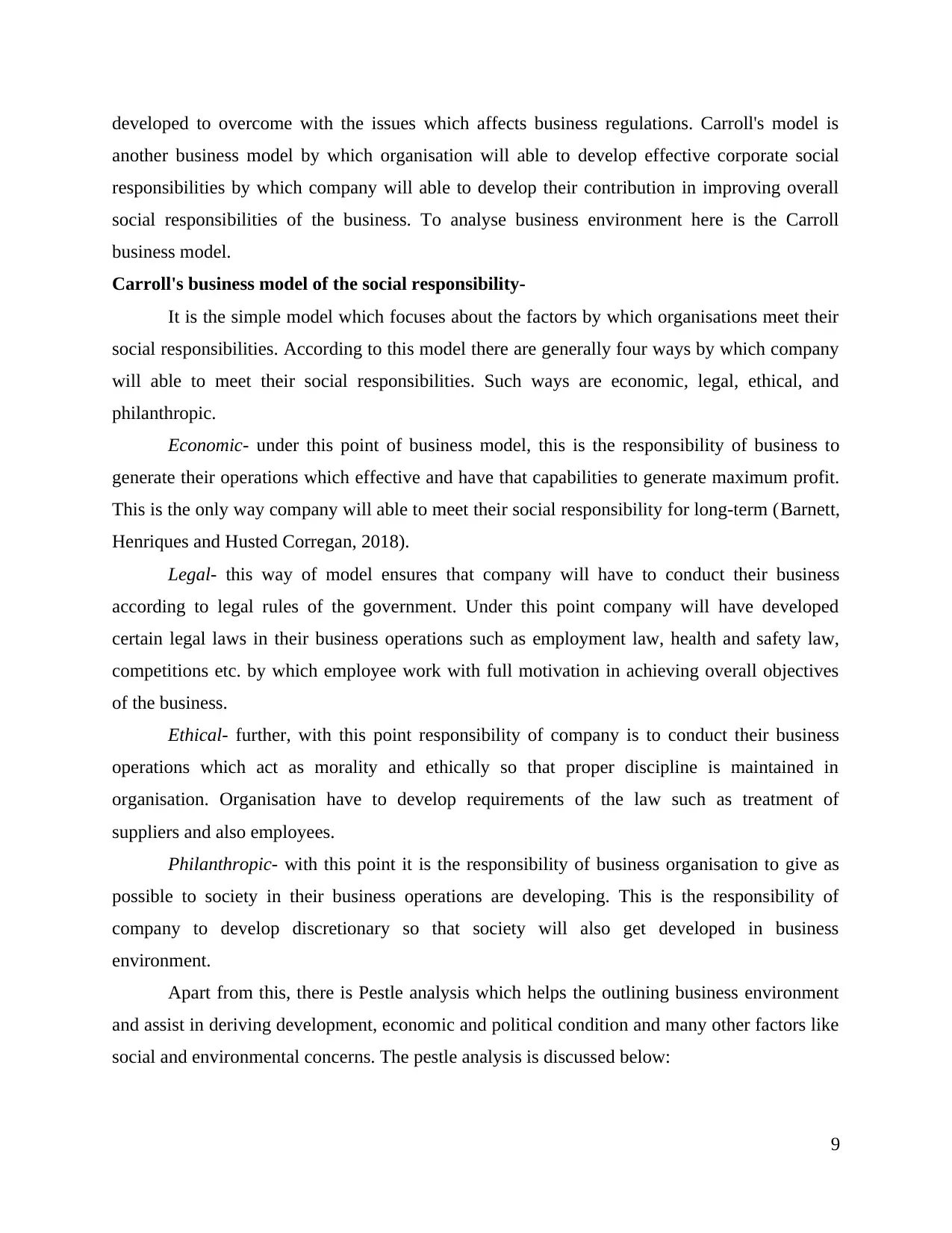
developed to overcome with the issues which affects business regulations. Carroll's model is
another business model by which organisation will able to develop effective corporate social
responsibilities by which company will able to develop their contribution in improving overall
social responsibilities of the business. To analyse business environment here is the Carroll
business model.
Carroll's business model of the social responsibility-
It is the simple model which focuses about the factors by which organisations meet their
social responsibilities. According to this model there are generally four ways by which company
will able to meet their social responsibilities. Such ways are economic, legal, ethical, and
philanthropic.
Economic- under this point of business model, this is the responsibility of business to
generate their operations which effective and have that capabilities to generate maximum profit.
This is the only way company will able to meet their social responsibility for long-term (Barnett,
Henriques and Husted Corregan, 2018).
Legal- this way of model ensures that company will have to conduct their business
according to legal rules of the government. Under this point company will have developed
certain legal laws in their business operations such as employment law, health and safety law,
competitions etc. by which employee work with full motivation in achieving overall objectives
of the business.
Ethical- further, with this point responsibility of company is to conduct their business
operations which act as morality and ethically so that proper discipline is maintained in
organisation. Organisation have to develop requirements of the law such as treatment of
suppliers and also employees.
Philanthropic- with this point it is the responsibility of business organisation to give as
possible to society in their business operations are developing. This is the responsibility of
company to develop discretionary so that society will also get developed in business
environment.
Apart from this, there is Pestle analysis which helps the outlining business environment
and assist in deriving development, economic and political condition and many other factors like
social and environmental concerns. The pestle analysis is discussed below:
9
another business model by which organisation will able to develop effective corporate social
responsibilities by which company will able to develop their contribution in improving overall
social responsibilities of the business. To analyse business environment here is the Carroll
business model.
Carroll's business model of the social responsibility-
It is the simple model which focuses about the factors by which organisations meet their
social responsibilities. According to this model there are generally four ways by which company
will able to meet their social responsibilities. Such ways are economic, legal, ethical, and
philanthropic.
Economic- under this point of business model, this is the responsibility of business to
generate their operations which effective and have that capabilities to generate maximum profit.
This is the only way company will able to meet their social responsibility for long-term (Barnett,
Henriques and Husted Corregan, 2018).
Legal- this way of model ensures that company will have to conduct their business
according to legal rules of the government. Under this point company will have developed
certain legal laws in their business operations such as employment law, health and safety law,
competitions etc. by which employee work with full motivation in achieving overall objectives
of the business.
Ethical- further, with this point responsibility of company is to conduct their business
operations which act as morality and ethically so that proper discipline is maintained in
organisation. Organisation have to develop requirements of the law such as treatment of
suppliers and also employees.
Philanthropic- with this point it is the responsibility of business organisation to give as
possible to society in their business operations are developing. This is the responsibility of
company to develop discretionary so that society will also get developed in business
environment.
Apart from this, there is Pestle analysis which helps the outlining business environment
and assist in deriving development, economic and political condition and many other factors like
social and environmental concerns. The pestle analysis is discussed below:
9
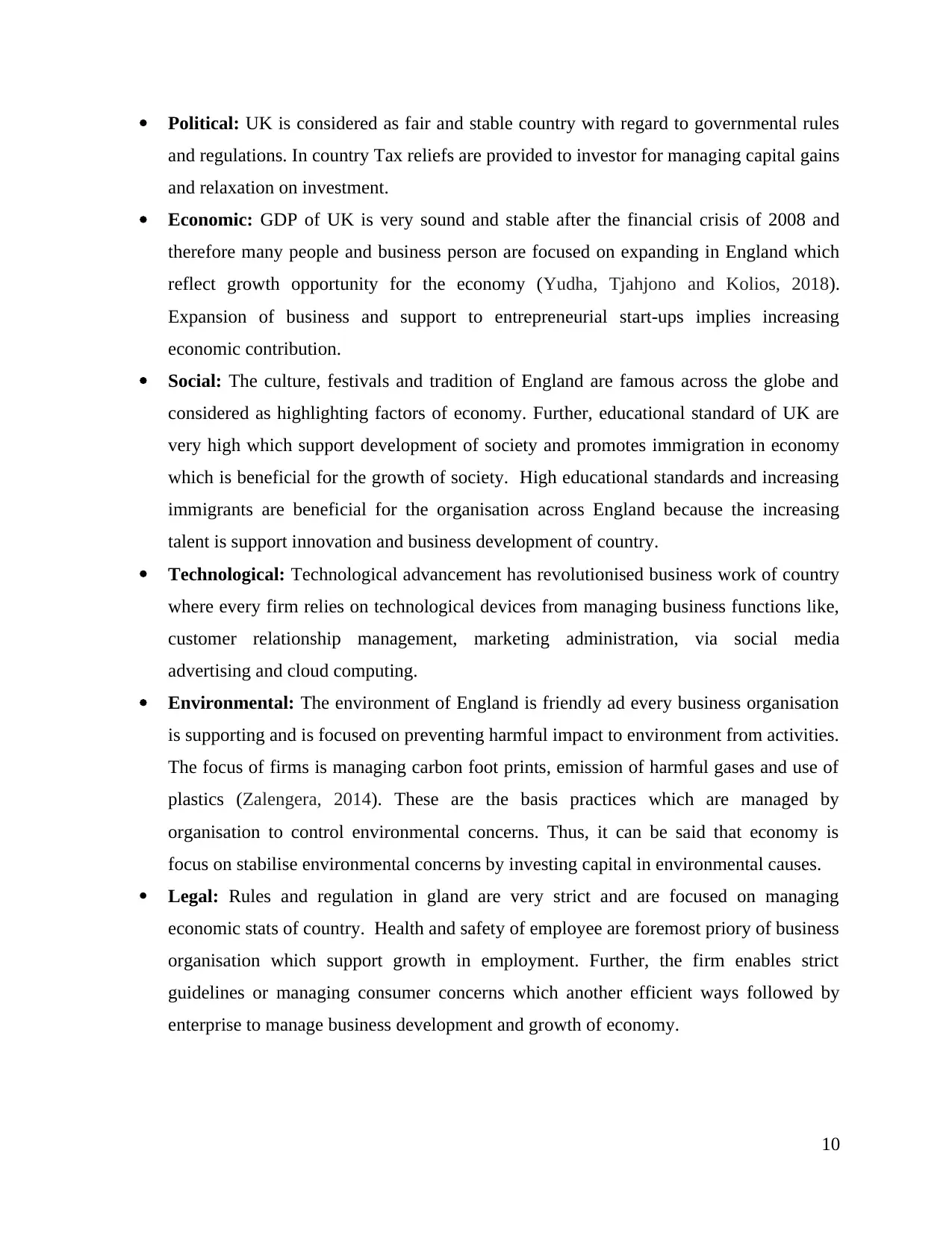
Political: UK is considered as fair and stable country with regard to governmental rules
and regulations. In country Tax reliefs are provided to investor for managing capital gains
and relaxation on investment.
Economic: GDP of UK is very sound and stable after the financial crisis of 2008 and
therefore many people and business person are focused on expanding in England which
reflect growth opportunity for the economy (Yudha, Tjahjono and Kolios, 2018).
Expansion of business and support to entrepreneurial start-ups implies increasing
economic contribution.
Social: The culture, festivals and tradition of England are famous across the globe and
considered as highlighting factors of economy. Further, educational standard of UK are
very high which support development of society and promotes immigration in economy
which is beneficial for the growth of society. High educational standards and increasing
immigrants are beneficial for the organisation across England because the increasing
talent is support innovation and business development of country.
Technological: Technological advancement has revolutionised business work of country
where every firm relies on technological devices from managing business functions like,
customer relationship management, marketing administration, via social media
advertising and cloud computing.
Environmental: The environment of England is friendly ad every business organisation
is supporting and is focused on preventing harmful impact to environment from activities.
The focus of firms is managing carbon foot prints, emission of harmful gases and use of
plastics (Zalengera, 2014). These are the basis practices which are managed by
organisation to control environmental concerns. Thus, it can be said that economy is
focus on stabilise environmental concerns by investing capital in environmental causes.
Legal: Rules and regulation in gland are very strict and are focused on managing
economic stats of country. Health and safety of employee are foremost priory of business
organisation which support growth in employment. Further, the firm enables strict
guidelines or managing consumer concerns which another efficient ways followed by
enterprise to manage business development and growth of economy.
10
and regulations. In country Tax reliefs are provided to investor for managing capital gains
and relaxation on investment.
Economic: GDP of UK is very sound and stable after the financial crisis of 2008 and
therefore many people and business person are focused on expanding in England which
reflect growth opportunity for the economy (Yudha, Tjahjono and Kolios, 2018).
Expansion of business and support to entrepreneurial start-ups implies increasing
economic contribution.
Social: The culture, festivals and tradition of England are famous across the globe and
considered as highlighting factors of economy. Further, educational standard of UK are
very high which support development of society and promotes immigration in economy
which is beneficial for the growth of society. High educational standards and increasing
immigrants are beneficial for the organisation across England because the increasing
talent is support innovation and business development of country.
Technological: Technological advancement has revolutionised business work of country
where every firm relies on technological devices from managing business functions like,
customer relationship management, marketing administration, via social media
advertising and cloud computing.
Environmental: The environment of England is friendly ad every business organisation
is supporting and is focused on preventing harmful impact to environment from activities.
The focus of firms is managing carbon foot prints, emission of harmful gases and use of
plastics (Zalengera, 2014). These are the basis practices which are managed by
organisation to control environmental concerns. Thus, it can be said that economy is
focus on stabilise environmental concerns by investing capital in environmental causes.
Legal: Rules and regulation in gland are very strict and are focused on managing
economic stats of country. Health and safety of employee are foremost priory of business
organisation which support growth in employment. Further, the firm enables strict
guidelines or managing consumer concerns which another efficient ways followed by
enterprise to manage business development and growth of economy.
10
⊘ This is a preview!⊘
Do you want full access?
Subscribe today to unlock all pages.

Trusted by 1+ million students worldwide
1 out of 18
Related Documents
Your All-in-One AI-Powered Toolkit for Academic Success.
+13062052269
info@desklib.com
Available 24*7 on WhatsApp / Email
![[object Object]](/_next/static/media/star-bottom.7253800d.svg)
Unlock your academic potential
Copyright © 2020–2025 A2Z Services. All Rights Reserved. Developed and managed by ZUCOL.




